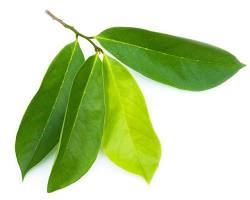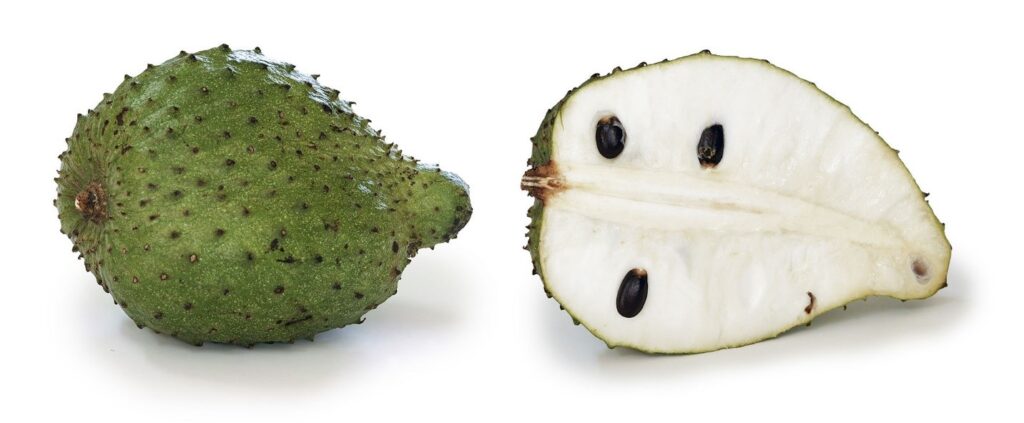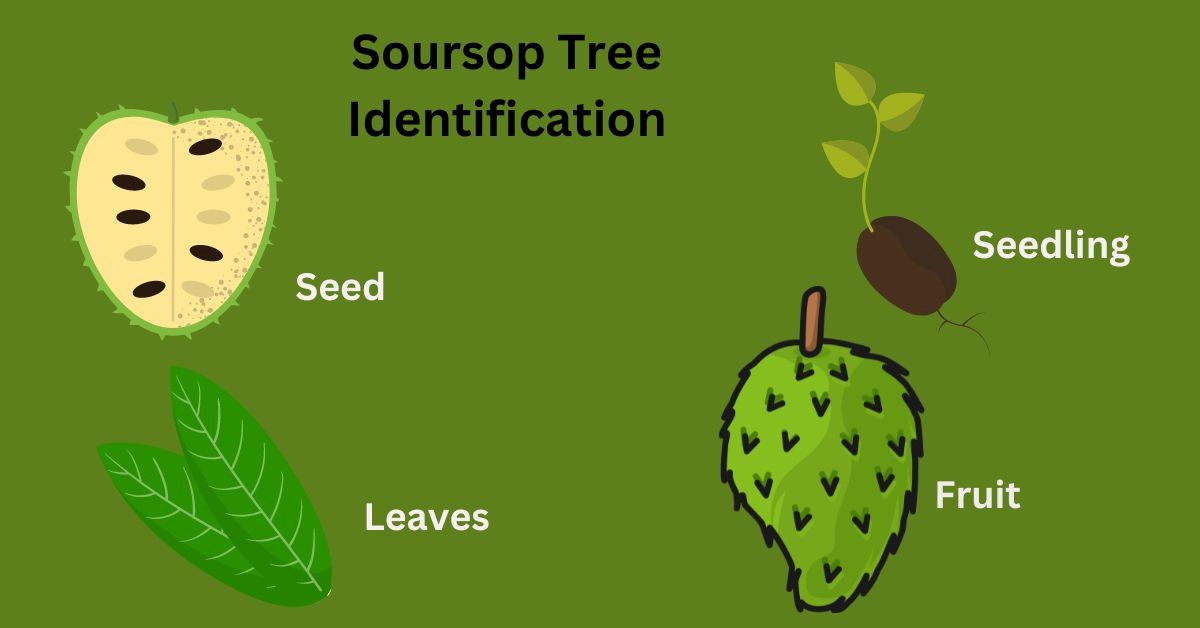As an avid nature enthusiast, I have always been fascinated by the diverse array of trees that inhabit our planet. One particular tree that has recently captured my attention is the soursop tree. The soursop tree, scientifically known as Annona muricata, is a tropical evergreen tree native to the Americas. Its distinct appearance and remarkable properties make it a truly unique addition to any landscape. Join me as we delve into the world of the soursop tree and discover what makes it so captivating.
Interesting Facts about Soursop Trees
Before we explore the physical characteristics of the soursop tree, let’s start with some interesting facts about this remarkable specimen. Did you know that the soursop tree is also known by several other names, including graviola, guanabana, and pawpaw? This tree can reach an impressive height of up to 30 feet and features large, glossy leaves that are a vibrant shade of green. Its fruit, the main attraction, is a prickly green oval-shaped delicacy with a creamy white flesh that is incredibly sweet and tangy.
Common Varieties of Soursop Trees
Now that your curiosity has been sparked let’s embark on a journey to explore the diverse tapestry of soursop tree cultivars. Within this botanical realm, each variety unveils its distinctive traits and flavors, offering a tantalizing array of options for enthusiasts and connoisseurs alike.
- Morada Variety: Among the many soursop varieties, the “Morada” stands as a beacon of distinction, revered for its regal bearing and sumptuous fruit. This variety is celebrated for its remarkable fruit size, often surpassing its counterparts with its generous proportions. Cloaked in a luxurious robe of deep purple skin, the Morada fruit captivates the eye with its opulent hues, hinting at the richness within. As one indulges in its creamy flesh, each bite is a symphony of flavors, with notes of sweetness harmonizing with subtle tanginess. The Morada variety is a testament to the soursop’s capacity for luxury and indulgence.
- Lisa Variety: On the opposite end of the spectrum lies the “Lisa” variety, renowned for its delicate charm and nuanced flavors. While its fruits may be smaller in stature, they compensate with abundant pulp, offering a lush and velvety texture that delights the palate. The Lisa variety embodies elegance and simplicity, with its unassuming exterior belying the treasure concealed within. With a higher pulp content, each spoonful of Lisa soursop fruit is a revelation, a burst of tropical goodness that transports the senses to paradisiacal realms. For those who savor subtlety and refinement, the Lisa variety epitomizes understated luxury.
- Other Varieties: Beyond the Morada and Lisa varieties, the soursop tree boasts an extensive family tree, with each cultivar adding its unique flair to the mix. From the “Pelea” variety, known for its exceptional juiciness, to the “Amarilla” cultivar, prized for its vibrant yellow skin and intense flavor, the possibilities are as diverse as they are tantalizing. Some varieties may showcase variegated foliage, adding a splash of color to the landscape, while others may exhibit subtle differences in aroma and taste, inviting exploration and discovery. Yet, amidst this kaleidoscope of diversity, all soursop trees share a common thread – an unwavering commitment to excellence and a dedication to delighting the senses with their enticing flavor and allure.
Regardless of the variety, all soursop trees share a similar growth habit and enticing flavor, ensuring that each encounter with this extraordinary fruit is a journey of discovery and delight. Whether you find yourself drawn to the luxury of the Morada, the elegance of the Lisa, or the myriad of other varieties that grace this botanical realm, one thing is sure – the soursop tree never fails to captivate and enchant, leaving an indelible mark on all who partake of its bounty.
Health Benefits of Soursop Tree Fruit
The soursop tree’s fruit is not just a treat for the taste buds; it’s a powerhouse of nutrition brimming with essential vitamins and minerals. As we dive deeper into its health benefits, you’ll discover many reasons to include it in your diet.
Loaded with vitamin C, the fruit becomes a vital ally in bolstering the immune system, fortifying the body’s defenses against infections and illnesses. Particularly, its potassium content plays a pivotal role in maintaining optimal heart function, regulating blood pressure, and supporting overall cardiovascular health.
But the benefits don’t end there. Within the soursop fruit lies a treasure trove of antioxidants, nature’s warriors in the battle against free radicals. These potent compounds scavenge and neutralize harmful molecules that wreak havoc in the body, potentially lowering the risk of chronic diseases such as cancer and cardiovascular disorders.
With every succulent bite of soursop fruit, you’re not just indulging in a tropical delicacy but nourishing your body from the inside out, reaping the rewards of nature’s bounty in every juicy morsel.
Traditional Uses of the Soursop Tree
Step into the annals of history, and you’ll find the soursop tree woven into the fabric of traditional medicine practices across cultures and continents. Its medicinal properties have been revered and harnessed from ancient civilizations to modern-day herbalists to alleviate many ailments. Explore the rich tapestry of traditional uses, and you’ll uncover a wealth of healing potential within every part of the tree.
With their anti-inflammatory and antimicrobial properties, the leaves have been brewed into teas and poultices to soothe aches, pains, and inflammations. Whether applied topically or ingested, they offer relief from arthritis to skin irritations, serving as a natural remedy for centuries. Meanwhile, the bark, prized for its febrifuge and analgesic properties, has been decocted into infusions to combat fevers, headaches, and pain. With its ability to induce perspiration and alleviate discomfort, it has earned a place of honor in the pharmacopeias of diverse cultures.
And let’s not forget the fruit itself, hailed as a panacea for various maladies throughout history. From digestive disorders to respiratory ailments, its pulpy flesh has been consumed fresh or processed into tinctures and extracts, offering relief and restoration to the weary and afflicted. Whether taken as a tonic or applied externally, the soursop fruit embodies nature’s bounty and the enduring wisdom of traditional healing practices. In the soursop tree, ancient traditions meet modern science, creating a tapestry of holistic wellness that transcends time and borders.
Culinary Uses of Soursop Tree Fruit
Not only does the soursop tree offer health benefits, but its fruit also lends itself to various culinary applications. The creamy flesh of the soursop fruit has a unique flavor profile that is sweet and tangy, making it a versatile ingredient in both sweet and savory dishes. In many tropical regions, soursop fruit is used to make refreshing beverages, ice creams, and sorbets. It can also be incorporated into fruit salads, smoothies, and even savory dishes like soursop curry. The culinary possibilities are endless with this extraordinary fruit.
Physical Characteristics of the Soursop Tree
The soursop tree boasts a distinctive appearance that differentiates it from other nearby trees. Let’s look at some distinctive features of the majestic tree:
1. Soursop Tree Bark
The bark of the soursop tree is an often-overlooked aspect of this remarkable tree. The bark is rough and dark brown, protecting the tree against pests and environmental elements. Traditional medicine practices have utilized the bark for its potential anti-inflammatory and analgesic properties. It is commonly prepared as an infusion or decoction and consumed to alleviate various ailments such as arthritis and rheumatism. The soursop tree’s bark truly showcases the tree’s holistic benefits.
2. Soursop Flowers
One cannot discuss the soursop tree without mentioning its captivating flowers. The soursop tree produces beautiful, pale yellow flowers that are visually stunning and fragrant. These flowers attract a wide range of pollinators, including bees and butterflies, which aid in the tree’s reproduction.
In addition to their aesthetic appeal, soursop flowers are also used in traditional medicine for their potential antimicrobial and anti-inflammatory properties. The flowers can be prepared as teas or infusions, offering a delightful and therapeutic experience.
3. Soursop Tree Leaves
Soursop tree leaves are a prominent feature of this magnificent specimen. These broad, elongated leaves are a glossy shade of green and give the tree a lush appearance. In traditional medicine, the leaves have been used to alleviate symptoms of various ailments, including hypertension and diabetes. They can be consumed as a tea or extract, offering potential health benefits. The leaves of the soursop tree truly embody the tree’s versatility and contribution to holistic wellness.

Image Credit: My Executive Fruits
Here’s a closer look at the characteristics of soursop tree leaves:
- Shape: Elliptical with pointed tips
- Size: Up to 8 inches long and 3 inches wide
- Color: Glossy dark green on top, pale green or slightly hairy underneath
- Arrangement: Alternate along the branches
- Veins: Prominent central vein with lateral veins branching out
Soursop tree leaves are vital to the tree’s overall health and well-being. They are responsible for photosynthesis, the process by which the tree converts sunlight, water, and carbon dioxide into food (glucose) that nourishes the entire plant. Additionally, the leaves help regulate the tree’s temperature through transpiration, the process of releasing water vapor into the atmosphere.
4. Soursop Seed
While the soursop fruit takes center stage, a hidden gem is nestled within its creamy flesh: the soursop seed. These seeds are crucial in the tree’s life cycle and hold potential for future generations. Let’s delve deeper into their characteristics and significance.
Appearance:
- Size: Soursop seeds are relatively large, typically ranging from 1/2 inch to 1 inch in length.
- Shape: They possess a flattened, oval shape with a smooth, shiny surface.
- Color: The seeds are a deep black, providing a stark contrast to the creamy white flesh of the fruit.
Structure:
- Hard outer shell: The seed is encased in a black outer shell, protecting the delicate inner embryo from damage during dispersal and storage.
- Inner kernel: Inside the shell lies a cream-colored kernel containing the embryo, the essential part for germination and new tree growth.
Significance:
- Propagation: Soursop seeds are the primary means of natural reproduction for the tree. When consumed by animals, the seeds are dispersed through their droppings, potentially landing in suitable locations for germination and establishing new trees.
- Planting: For those interested in cultivating soursop trees, the seeds can be carefully extracted, cleaned, and prepared for planting. However, it’s important to note that germination success rates can vary, and propagation through grafting is often preferred for maintaining desired fruit quality and characteristics.
Important Note: It is crucial to exercise caution when handling soursop seeds. While the flesh of the fruit is safe for consumption when ripe, the seeds contain toxins that can cause digestive issues and other health problems if ingested. It’s essential to properly dispose of the seeds after enjoying the fruit and avoid consuming them.
5. Soursop Tree Fruit
Finally, we arrive at the star of the show – the soursop fruit itself. The fruit of the soursop tree is a prickly green oval-shaped delicacy that is as visually intriguing as it is delicious. When ripe, the fruit’s skin turns a slightly yellowish hue, indicating its readiness for consumption. The flesh of the soursop fruit is creamy and white, with a unique flavor profile that combines sweetness and tanginess.
The fruit can be enjoyed fresh or used to create a variety of delectable treats such as smoothies, ice creams, and desserts. Its versatility and irresistible taste make it a beloved fruit in many tropical regions.

Image Credit: Wikipedia
Where to Find Soursop Trees
If the allure of the soursop tree enchants you and wishes to witness its beauty firsthand, you may be wondering where to find these magnificent trees.
Soursop trees are native to the Americas, specifically the tropical regions of Central and South America. However, due to their popularity, they have been introduced to other tropical areas around the world, including Nigeria.
If you’re fortunate enough, you can often find soursop trees in botanical gardens, tropical fruit farms, and even private gardens. These locations provide the perfect opportunity to immerse yourself in the wonder of the soursop tree.
Conclusion
The soursop tree is a true marvel of nature. Its distinct physical characteristics, health benefits, and traditional uses make it a tree of remarkable versatility. From its rough bark to its captivating flowers, every part of the soursop tree has a story to tell. Whether you’re savoring the creamy flesh of its fruit or exploring its traditional medicinal properties, the soursop tree is an extraordinary addition to our natural world. So, the next time you come across a soursop tree, take a moment to appreciate its beauty and its wonders. Click here for more interesting reads about different tree species.

